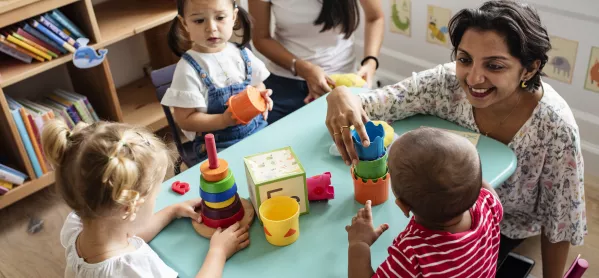- Home
- News
- Early Years
- Three extra Reception pupils per class fell behind in pandemic
Three extra Reception pupils per class fell behind in pandemic

Covid pandemic disruption has resulted in three extra early years children per class not reaching the expected development standards for their age group during the year, according to a new report.
A research project commissioned by the Education Endowment Foundation (EEF) has found that four- and five-year-olds were less likely to meet the expected levels of development in 2021 than they were before the pandemic.
Using a sample of early years foundation stage data, the researchers looked at the impact of the pandemic on the development of children who were in Reception class for the 2020-21 school year, which began six months after the first Covid lockdown.
- Analysis: Proof of pandemic’s impact on EYFS shows a need to act
- More from the EEF: Poorer pupils extra month behind in maths
- Related: Third of teachers warn of 18-month learning gap
The findings, published today, show the proportion of children in their sample reaching the expected levels in all areas - communication and language; physical development; literacy; maths; and personal, social and emotional development - was 59 per cent in 2021, compared with 72 per cent for the 2019 cohort.
And this difference is equivalent to three more children in every classroom not reaching the expected levels by the end of the school year.
The EEF said the findings were “concerning”, while the Association of School and College Leaders (ASCL) said they added to the “worrying picture” of the damage done to young children’s education during the pandemic.
In a survey of schools supporting the findings, it was found that when this cohort of children started school in 2020, over three-quarters (76 per cent) said that they needed more support than those starting school before the pandemic, although this had fallen to just over half (56 per cent) by the end of the school year.
The report found that all pupils’ learning had been negatively affected by the pandemic, but that the attainment gap between socially disadvantaged pupils and their peers had widened across all age groups.
And it found evidence that younger year groups in primary schools had been the worst affected by the pandemic.
‘Concerning’
Becky Francis, chief executive of the EEF, said the results were “concerning” and added to a “growing body of research that gives us a more robust understanding of how children and young people have been affected by the pandemic, and the measures that will need to be taken to facilitate their recovery and move learning forwards”.
Geoff Barton, general secretary of ASCL, said: “This research adds to the worrying picture of the damage done to our youngest children’s education by the impact of the pandemic.
”Constant periods of disruption have been very difficult to mitigate for all age groups but especially so for young children because of the difficulty of teaching this age group remotely.”
He added that schools had been ”let down by the government’s recovery programme”, which he described as both “inadequately funded and a confusing tangle of different programmes, routes and bureaucracy”.
A Department for Education spokesperson said: “Our ambitious recovery plan continues to roll out across the country, with nearly £5 billion invested in high-quality tutoring, world-class training for teachers and early years practitioners, additional funding for schools, and extending time in colleges by 40 hours a year.
“We are already seeing children making encouraging progress with two-thirds of primary schools using the Nuffield Early Languages Intervention programme (NELI) along with over 1 million tutoring courses being delivered through the National Tutoring Programme.”
The EEF-commissioned study was conducted by a team from the University of York, the National Institute of Economic and Social Research (NIESR) and the Education Policy Institute (EPI), and was based on 94 schools and 1,105 families, using data for 3,253 children overall.
It adds to other research that has highlighted the growing scale of the catch-up challenge facing school-age pupils in the wake of the Covid pandemic.
A report earlier this year showed that disadvantaged pupils were a month further behind their classmates in maths than they were at the start of Covid, while survey results released in January showed that a third of teachers warned of an 18-month learning gap.
You need a Tes subscription to read this article
Subscribe now to read this article and get other subscriber-only content:
- Unlimited access to all Tes magazine content
- Exclusive subscriber-only stories
- Award-winning email newsletters
Already a subscriber? Log in
You need a subscription to read this article
Subscribe now to read this article and get other subscriber-only content, including:
- Unlimited access to all Tes magazine content
- Exclusive subscriber-only stories
- Award-winning email newsletters
topics in this article



